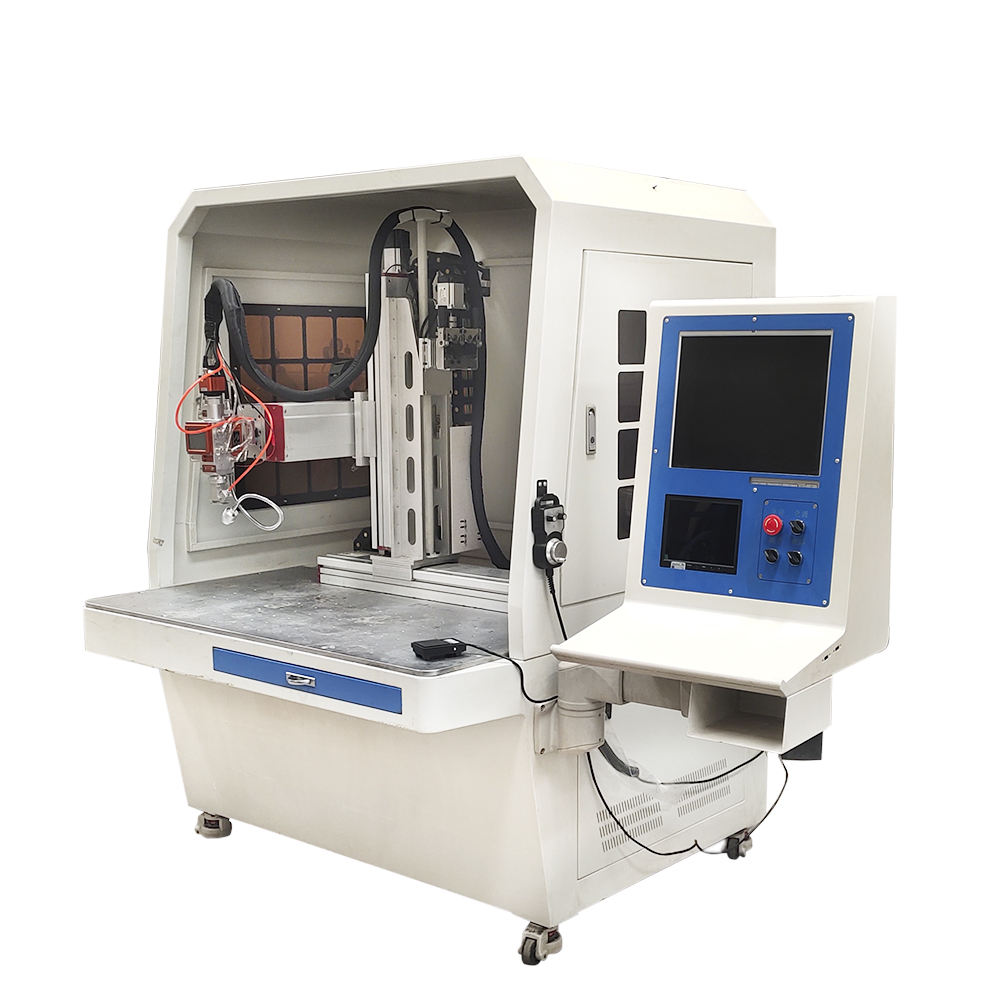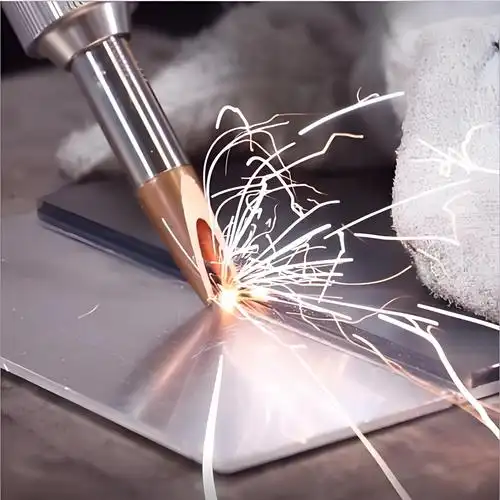Introduction to CNC Laser Welding Machine
A CNC laser welding machine is an advanced manufacturing tool that uses high-energy laser beams, precisely controlled by computer numerical control (CNC) systems, to join metal or thermoplastic components. Unlike traditional welding methods such as TIG (Tungsten Inert Gas), MIG (Metal Inert Gas), or manual arc welding, a CNC laser welding machine offers exceptional precision, faster processing speeds, and a high level of automation.
In conventional welding, the heat source is relatively large and less controlled, which can lead to wider heat-affected zones, material distortion, and lower repeatability. In contrast, a CNC laser welding machine delivers a focused laser beam that creates deep, narrow welds with minimal thermal deformation. The CNC control system ensures that every movement, angle, and welding path is executed with micron-level accuracy, enabling consistent quality even in complex geometries or tight tolerances.
The adoption of CNC laser welding machines has been steadily growing in modern manufacturing sectors such as automotive, aerospace, medical devices, precision electronics, and energy equipment. With industries demanding lighter, stronger, and more aesthetically perfect components, CNC laser welding has become a key technology for achieving high-performance, cost-efficient, and scalable production.

cnc laser welding machine
How a CNC Laser Welding Machine Works?
A CNC laser welding machine integrates two core technologies—computer numerical control (CNC) and advanced laser welding—into one highly precise, automated system. The CNC control system acts as the “brain” of the machine, interpreting digital design files (such as CAD/CAM programs) and converting them into precise movements of the welding head. This ensures that every weld follows the exact coordinates, angles, and depths required by the design, eliminating the inconsistencies often seen in manual welding.
At the heart of the process is the laser beam, which is generated by either a fiber laser or a CO₂ laser source. The beam is focused through a high-precision optical lens onto a small spot on the workpiece. At this focal point, the energy density becomes extremely high, causing the metal surface to rapidly heat, melt, and form a molten pool. As the CNC-controlled welding head moves along the programmed path, the molten metal solidifies and fuses the materials together with exceptional accuracy. The rapid heating and cooling cycles minimize heat-affected zones, reducing material distortion and preserving the mechanical properties of the base metal.
CNC programming plays a critical role in quality and repeatability. Operators can set and adjust parameters such as laser power, pulse frequency, welding speed, and focal position directly in the control software. This means the machine can execute complex welding patterns—whether straight seams, curved joints, or intricate geometries—without deviation, even over long production runs.
In terms of laser types, fiber laser welding is known for its higher energy efficiency, lower maintenance needs, and ability to work with reflective metals like aluminum, copper, and brass. It delivers a smaller, more intense spot size, making it ideal for micro-welding and high-speed applications. CO₂ laser welding, on the other hand, uses a gas mixture as the lasing medium and produces a longer wavelength. While it is less efficient with reflective materials, it is excellent for welding thicker sections of steel and offers smoother weld surfaces for certain applications.
By combining CNC automation with precision laser technology, a CNC laser welding machine ensures unmatched consistency, minimal rework, and superior control over weld quality—key advantages for industries where precision and efficiency are non-negotiable.

cnc laser welding machine
Key Features of CNC Laser Welding Machine
A CNC Laser Welding Machine is engineered to deliver exceptional welding performance, combining advanced laser technology with computer numerical control for unparalleled precision and efficiency. The following core features make it a preferred choice in modern manufacturing:
High-Precision Positioning & Repeatability
The CNC system ensures micron-level positioning accuracy and consistent repeatability, enabling flawless welds across multiple workpieces without manual intervention.
High Energy Density for Superior Weld Quality
Concentrated laser energy produces deep penetration welds with smooth surfaces, free from porosity and with minimal spatter. The result is a strong, aesthetically clean joint requiring little to no post-processing.
Capability for Complex Geometries & Irregular Shapes
CNC programming allows the machine to handle intricate welding paths and irregular components, making it ideal for precision industries such as aerospace, medical device manufacturing, and electronics.
Low Heat Input for Reduced Distortion
The focused laser beam minimizes the heat-affected zone (HAZ), reducing thermal stress and deformation on delicate or thin-walled materials.
Automation & Mass Production Capability
Seamless integration with automated production lines enables high-throughput, continuous operation, significantly improving productivity while maintaining consistent quality standards.
Materials Suitable for CNC Laser Welding Machine
CNC laser welding machines are versatile and capable of joining a wide range of metals and alloys. The selection of material and corresponding laser parameters is critical to achieving defect-free welds.
-
Stainless Steel (SS)
Stainless steel is one of the most common materials for CNC laser welding due to its excellent absorption of laser energy and ability to produce smooth, corrosion-resistant weld seams. Both austenitic (e.g., 304, 316) and ferritic grades can be welded with minimal post-processing.
-
Carbon Steel
Low-carbon and medium-carbon steels can be welded effectively, but care must be taken to control heat input to avoid hardness increases and cracking in the heat-affected zone (HAZ). Precise CNC control ensures uniform penetration and minimal spatter.
-
Aluminum Alloys
Aluminum and its alloys have high thermal conductivity and reflectivity, making laser wavelength and power settings crucial. Fiber lasers with shorter wavelengths (around 1 µm) improve absorption compared to CO₂ lasers, reducing porosity and ensuring consistent penetration.
- Copper and Brass
Copper’s high reflectivity and conductivity require high peak power and optimized beam delivery. Green or blue laser sources (wavelengths ~515 nm or 450 nm) offer superior absorption for copper and brass, resulting in stronger, defect-free welds.
Why Material-Specific Settings Matter?
Different metals have unique thermal and optical properties. The correct choice of laser wavelength, pulse duration, and focus position is essential:
Shorter wavelengths (fiber lasers) are more effective for reflective metals like aluminum and copper.
CO₂ lasers (10.6 µm wavelength) are well-suited for non-reflective materials and thicker sections.
CNC programming ensures that welding speed, laser power, and spot size are tailored to each material, maximizing joint integrity and minimizing defects.

Laser Welding Metal
Advantages of CNC Laser Welding Machine Over Traditional Welding
Higher Welding Speed – Reduced Production Cycle
CNC laser welding can achieve welding speeds several times faster than conventional MIG, TIG, or arc welding. The concentrated laser beam enables deep penetration at high travel speeds, significantly reducing production cycles and increasing throughput.
Superior Welding Quality – Strength Equal to or Greater Than Base Material
Laser welds are extremely precise, with minimal porosity and uniform microstructure. The resulting joint often reaches or exceeds the mechanical strength of the base metal, ensuring reliable performance even in demanding applications.
Smaller Heat-Affected Zone (HAZ) – Less Distortion and Post-Processing
The high energy density of the laser allows for rapid heating and cooling, producing a narrow HAZ. This minimizes thermal distortion, reduces residual stress, and limits the need for costly post-weld machining or straightening.
Lower Labor Costs – Fully Automated Operation
When integrated with CNC systems and robotic arms, laser welding can operate continuously with minimal human intervention. This automation reduces labor costs, improves process consistency, and ensures high-volume production efficiency.
Capability for Complex Welding Tasks – High Flexibility
CNC laser welding is highly adaptable to complex geometries, thin materials, and dissimilar metal combinations. It enables welding of intricate designs that are difficult or impossible to achieve with conventional welding techniques.
Choosing the Right CNC Laser Welding Machine
Selecting the right CNC laser welding machine is essential for achieving optimal performance, efficiency, and long-term reliability. Here are the key factors to consider:
-
Power Selection (1000W, 1500W, 2000W, 3000W, etc.)
The laser power directly affects penetration depth and welding speed. Lower power options like 1000W–1500W are suitable for thin sheet metals and precision components, while 2000W–3000W models handle thicker materials and high-speed industrial production.
-
Worktable Size and Travel Range
The worktable dimensions and CNC travel range should match the size of your workpieces. For specialized applications, customized worktables can be designed to accommodate irregular or oversized parts, ensuring maximum efficiency and safety during operation.
-
CNC System Compatibility
A well-optimized CNC control system ensures smooth operation and high repeatability. Our machines feature intuitive user interfaces, pre-set parameter configurations for common materials, and comprehensive operation tutorials so operators can start production quickly.
-
Fiber Type and Laser Source Brand
For stable performance, our machines adopt high-quality fiber optics and laser sources from top domestic brands, with wavelengths of 1080 ± 5 nm or 1064 nm, ensuring consistent beam quality and energy output for various welding applications.
-
After-Sales and Technical Support
Reliable technical support is crucial for minimizing downtime. We provide one-year warranty, detailed usage tutorials, and remote troubleshooting to help customers quickly resolve issues and maintain peak performance.
Conclusion and Call to Action
In today’s competitive manufacturing environment, the CNC Laser Welding Machine has become an indispensable tool for achieving high-precision, high-speed, and consistent welding results. By combining advanced CNC control with fiber laser technology, it not only enhances production efficiency but also ensures superior weld quality with minimal rework.
Whether you are working with stainless steel, carbon steel, aluminum, or other metals, a well-selected CNC Laser Welding Machine can significantly reduce production time, lower operating costs, and improve product reliability — giving your business a strong competitive edge.
Contact us today to discuss your production needs and find the CNC Laser Welding Machine that’s perfectly tailored for your business. Our technical team is ready to provide expert advice, customization options, and full after-sales support to ensure you get the best welding performance possible.
 ZS Laser Equipment
ZS Laser Equipment


WhatsApp
Scan the QR Code to start a WhatsApp chat with us.